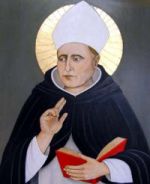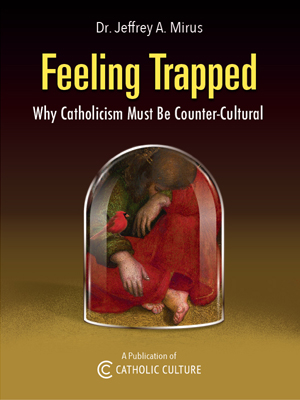Catholic Activity: Advent Wreath: Making Your Own
Advent for children should rightly be a very busy time, starting with the making of the Advent wreath. This is a sacramental in which the whole meaning of Advent is symbolized—and symbols are a language children understand very easily. Included below are guidelines for explaining this symbolism to your children, and also a family blessing for the wreath.
DIRECTIONS
If the wreath is to be hung from the ceiling, the frame can be made in a number of ways. It can be wire coat-hangers unshaped and twisted to form a circle (with cross-pieces to brace it); it can be cut from plywood; it can be a cast-off floral wreath frame; it can be several circles of heavy cardboard cut and taped together and braced with cross-pieces, or it can be (as is ours) the circular wooden frame from an old ash-sifter — which works incredibly well. Any of these ways is all right, so long as you make it. That is the most important point: to make it.
Candleholders, improvised or ready-made if suitable, can be wired to, soldered to, or cut into the frame at the four points of the compass (we made ours of bouillon tins, nailed to the braces and silvered). On a hung wreath the greens are fastened to show from the bottom rather than the top. It is tied with purple ribbons between the four candles and hung by the ribbons from the ceiling. If purple ribbon is not available for Advent, you can dye white ribbon, and at Christmas you may if you wish change the ribbons and candles to red or gold, the colors of divine joy and love.
One year we sprayed our wreath with water glass, an egg preservative purchased at drugstores, but the advantage is debatable. It does not make the wreath noninflammable, although it would burn with difficulty; it does make it dry and crumbly. This may be because we use crow's-foot (an evergreen creeper) and princess pine for our wreaths, and these get dry before the season is over. If you decide to spray your wreath, place it on a wide spread of newspapers on the floor or table so that you won't have water glass all over everything. The principal protection against fire is to have the candleholders firm and the candles firmly in them. Our bouillon cube tins provide three or four inches of fireproof candleholder. We never let the candles burn down too far, nor light them unless there is a grownup present, and we have never had any trouble with our Advent wreaths beyond some soot on the ceiling one year, and one scorch mark because we hung it too high. The candles need not be blessed candles, although the beeswax candles burn the most beautifully and more slowly, and there are plenty of ways to use up the leftover candle stubs.
A table wreath can be a simple wreath of greens resting in a pan of water to keep them fresh, or a large ringmold filled with wet sand which will keep the greens fresh; or you may put greens in a ringmold filled with wet plaster (of course they do not come out!). Candlesticks are placed on the table inside the wreath. The ribbon may be tied to the candle, or it may bind the wreath or be tied on it in four bows between the candles.
Well, what does it mean?
The circle is a symbol of eternity and the never-endingness of God, and the evergreen is a symbol of eternal life and the never-changingness of God. Tertullian in the third century wrote to the Christians of his day: "You are a light of the world; a tree ever green." Children love to learn by symbols.
We wondered one year if the smaller ones remembered. "What does the circle of the wreath mean, dear? Do you remember?"
A small boy thought very hard and then said: "I can't tell you but I can show you." He hugged himself with both arms and went round and round in a wide circle. "See? God never stops."
"You mean God goes round in circles?"
"No! God doesn't go round in circles. God never stops means God never ends. He thought "He never begins, either. Like circles." It is what the catechism says — only in his words....
Did God have a beginning? God had no beginning. He always was and always will be.
The four candles in the wreath are for the four weeks of Advent. Three candles are white for divine innocence and one is rose to match the rose vestments permitted on Gaudete Sunday (third Sunday of Advent), reminding us of the shout of joy in that day's Introit. . . . "Rejoice (gaudete) in the Lord always, again I say, rejoice." The rose-colored candle says that the promise is almost fulfilled; come, everyone, rejoice!
The ribbon is purple for penance, but it is a different kind from the penance of Lent. That penance is heavy with sorrow, bitter and painful with the knowledge of our sins. We are sinners in Advent, too, but the emphasis is differently placed. The emphasis is on our longing, our need — not only for the great graces of the feast of His Nativity, for the renewing in our hearts of the mystery of His birth — but our need to be ready for the glorious moment of His Second Coming. This penance is a chastening, a cleansing, a hurrying and a waiting, a longing and an aching that is at the same time both painful and sweet. Like the family waiting for the baby to come, we could all but die with the waiting — for His birthday, and His coming again in glory.
The family gathers for the blessing of the wreath on the Saturday night before the first Sunday of Advent, or on the first Sunday itself, with the father or some older member of the family reading the blessing.
Blessing of the Advent Wreath
Father: Our help is in the name of the Lord. All: Who hath made heaven and earth.
Father: Let us pray. O God, by Whose word all things are sanctified, pour forth Thy blessing upon this wreath, and grant that we who use it may prepare our hearts for the coming of Christ and may receive from Thee abundant graces. Through Christ Our Lord. All: Amen.
(Sprinkles wreath with holy water.)
The father or leader reads the prayer for the first week, then holds up the youngest child to light the first candle, which is also lighted all through the week when the family gathers in the room with the wreath. Two candles are lighted by the oldest child the second week, three the third by the mother, four the fourth by the father. Leaflets with the prayers are available for a few cents each, or you may read the prayers from the missal, as they are the Advent Sunday Collects.
In families where there are many children it is impossible to satisfy all who want to light candles since there are only four Sundays in Advent. We solve this problem in our house by letting them take turns lighting the candles during the week. They are never lighted unless an adult is present. When there is a guest who asks: "What a pretty wreath. Is it something special, with the candles like that?" the children love to explain: "It's an Advent wreath, and the four candles are for the four weeks of Advent. Every week we light another candle, you see, and the light around it grows bigger. That means that the birthday of the Light of the world is coming soon. Baby Jesus, you know, and Christmas. It's His birthday and He's the Light of the World."
Activity Source: Year and Our Children, The by Mary Reed Newland, P.J. Kenedy & Sons, New York, 1956






